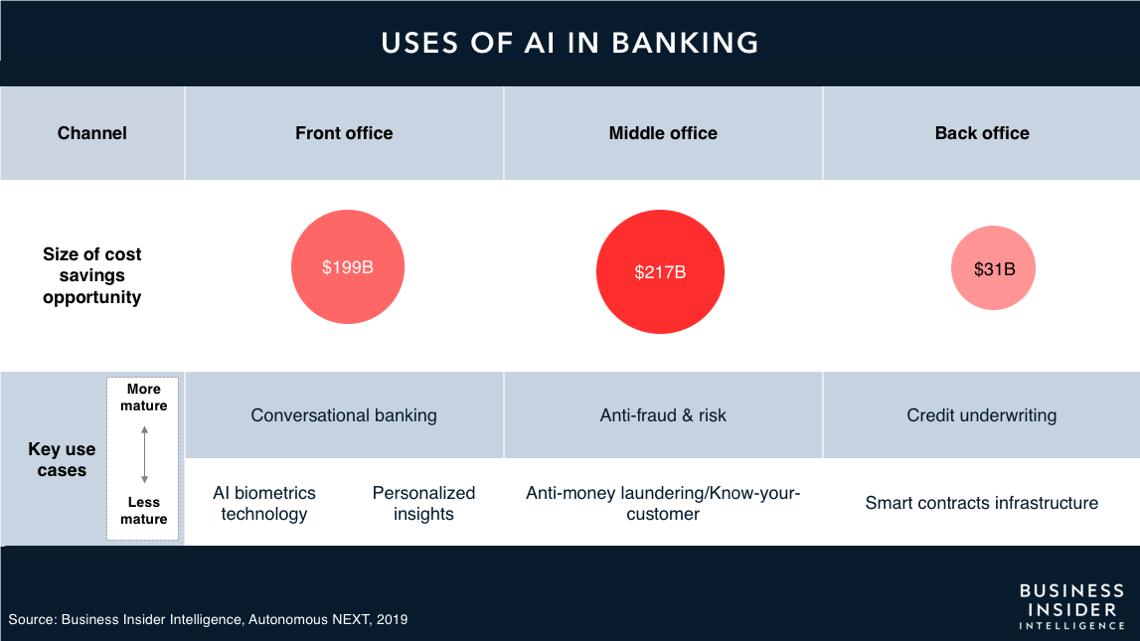AI is evolving on fast pace. Financial organizations are already using AI technologies to identify fraud and unusual transactions, personalize customer service, help make decisions on creditworthiness, using natural language processing on text documents, and for cybersecurity and general risk management.
Over the past decades, banks have been improving their methods of interacting with customers. They have tailored modern technology to the specific character of their work. As an example, in the 1960s, the first ATMs were installed, and ten years later, there were already cards for doing transactions and payment. At the beginning of this century, users learned about round-the-clock online banking, and in year 2010, they heard about mobile banking. But the development of the financial system didn’t stop here, as the digital age is opening up new opportunities — the use of Artificial Intelligence in banking and financial institutions. By 2023, banks are projected to save approximately $447 billion by developing and implementing AI applications. Some of the fine examples are below.
Mobile banking
AI functionality in mobile apps is becoming more proactive, personalized, and advanced. For example, one of Canadian Bank has included Siri in its iOS app. Now, to send money to another card, it’s enough to say something like: "Hey, Siri, send $20 to Alex!" - and confirm the transaction using Touch ID.
Thanks to AI, banks generate almost 66% more revenue from mobile banking users in comparison when customers visit branches. Banking organizations are paying close attention to emerging technology to improve their quality of services and remain competitive in the market.
AI Chat Bots
Chat bots are AI enabled conversational interfaces. This is one of the most popular cases of applying AI in banking. Bots communicate with customers on behalf of the bank without requiring large expenses. Researchers have estimated that financial institutions save four minutes for each communication that the chat bot handles.
Since customers use mobile apps to carry out monetary transactions, banks embed chat bot services in them. This makes it possible to attract users’ attention and create a brand that is recognizable in the market.

For example is the launch of the Ceba chat bot, which brought great success to the Australian Commonwealth Bank. With its help, about half a million customers were able to solve more than two hundred banking issues: activate their cards, check account balances, withdraw cash, etc.
Another example, Bank of America launched a chat bot that sends users notifications, informs them about their balances, makes recommendations for saving money, and provides updates to credit reports, and so on. This is the way the bank helps its clients to make informed decisions.
Data collection and analysis
Banking institutions record millions of business transactions every day. The volume of information generated by banks is enormous, so its collection and registration turn into an overwhelming task for employees. Structuring and recording this data is impossible until there is a plan for its use. Therefore, determining the relationship between the collected data is challenging, especially when a bank has thousands of clients.
There used to be the following approach: a client came to a meeting with a bank employee who knew their name and financial history and understood what options were better to offer. But that's history now. With the wealth of data coming from countless transactions, banks are trying to implement innovative business ideas and risk management solutions.
AI-based apps collect and analyze data. This improves the user experience. The information can be used for granting loans or detecting fraud. Companies that estimated their profit from Big Data analysis have reported an average increase in revenue by 8% and a reduction in costs by 10%.
Risk management
Extension of credit is quite a challenging task for bankers. If a bank lends money to insolvent customers, it can get into difficulties. If a borrower loses a stable income, this leads to default. According to statistics, in 2020, credit card delinquencies in the U.S. rose by 1.4% within six months.
AI powered systems can appraise customer credit histories more accurately to avoid this level of default. Mobile banking apps track financial transactions and analyze user data. This helps banks anticipate the risks associated with issuing loans, such as customer insolvency or the threat of fraud.
Transaction Data Enrichment
It is an important part of financial management, both for financial institutions and consumers. It uses machine learning and artificial intelligence to decipher unintelligible strings of characters that represent transactions and merchants and converts them to readable text that shows each merchant's name and lists their address and city. It shows the local merchant's location, rather than the central corporate office. This method of turning hard-to-understand data into easy-to-read information, helps both banks and customers to understand where they spent their money and with whom. It reduces both customer service calls and fraud research costs, because the customers can tell what they bought and where they bought it. Fraud detection reduces the number of people calling about mystery charges on their credit card bill, because they understand what those charges mean. Fewer calls mean less fraud research, which reduces costs. Most importantly, these clear descriptions help developers put financial data into context so they can more easily categorize and analyze purchases. This helps with things like budgeting, analyzing spending habits, credit scoring and being able to predict future earning and spending issues.
Data security
According to the Federal Trade Commission report for 2020, credit card fraud is the most common type of personal data theft.
AI based systems are effective against wrongdoers. The programs analyze customer behavior, location, and financial habits and triggers a security mechanism if they detect any unusual activity. ABI Research estimates that spending on AI and cybersecurity analytics will amount to $96 billion by the end of 2021.
Amazon has already acquired harvest.AI - an AI cyber security start up - and launched Macie - a service that applies Machine Learning to detect, sort, and structure data in S3 cloud storage.
Closing Note
There are more ways to apply AI in the finance industry. According to OpenText survey, almost 80% of banks recognize the benefits of AI, 75% of them already make use of this technology, and about 46% plan to implement AI-based systems in the near future.
AI-powered solutions become an integral part of companies’ development strategies, helping them to remain competitive in the market. This technology minimizes operating costs, improves customer support, and automates processes.
Also, the next thing which has major significance now is AI ethics.




